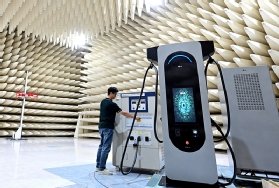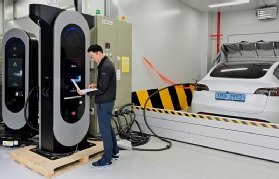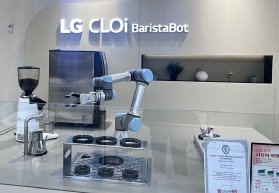LGE looks to mean business with tech pivot

At first glance, Airbnb, Netflix, Nokia and Slack do not seem like likely bedfellows. Granted they are all digital technology leaders in their respective industry sectors, but that is not all they have in common. They are all examples of corporate success after a major industry pivot.
Companies making strategic pivots usually do so only when necessary for their long-term prosperity. Netflix was never going to hit its current giddy heights in video streaming by continuing as a DVD distributor. Nokia showed its market position is down to being more plugged in than its days of being a wood pulp mill. Slack took its original idea of online collaboration to a much different place. So it is fascinating to see why consumer electronics giant LG Electronics (LGE) has pivoted to a new business arena.
LGE describes itself as “a leading manufacturer of consumer and commercial products from TVs, home appliances, air solutions, monitors, automotive components and solutions” to an array of other audio and entertainment products. A fundamental part of the current LGE brand is the message “Life’s Good”, which has the associated mission of “innovation for a better life” to create “a better life for people and a better future for our planet” through smart life solutions.
A quick look at the corporation’s latest financial statements reveals that LGE’s financial life is rather good, making the business case for its need to pivot more interesting. For the 2023 fiscal year, LGE’s four companies – home appliance and air solutions, home entertainment, vehicle component solutions and business solutions – delivered a combined global revenue of $61.07bn (KRW84.2tn), generating a gross profit of $14.36bn and a net profit of $830m. So far, so very good.
But 2023 also marked the year in which the company unveiled its business transformation plan to pivot from being a global home appliance brand to a “smart life solution company” that can connect and expand customers’ diverse experiences while driving global annual revenues of $72.46bn by 2030.
In a statement as to what this change would mean, LGE said it would “continue to pursue its bold vision to transform and leap forward as a smart life solution company that connects and expands customers’ various spaces and experiences, rather than resting on its current position as the best home appliance brand that provides quality products”.
Power in the platform
There will be four pillars of transformation in this plan: existing business growth maximisation; platform service; business-to-business (B2B); and – new to LGE – industries such as state-of-the-art electric vehicle battery charging units.
The potential for getting this right is huge. LGE calculates that around 500 to 700 million of its products are in use around the world, with the company selling almost 100 million appliances and TV units every year. It added that if these devices were connected and upgraded to be able to provide platform services, it could be “truly powerful”. At the same time, LGE said it also had a unique opportunity to take advantage of real-life data gathered from the billions of LGE smart products and other internet of things (IoT) devices in active use.

To ensure the qualitative growth of the business, the company plans to invest more than $36.23bn by 2030. This includes a research and development (R&D) investment of more than $18.12bn, facility investment of more than $12.32bn and strategic investment of $5.07bn.
In practice, this means the corporation making a shift to a platform-based service business model, accelerating B2B areas and procuring new growth engines based on competitive edge as the pillars to focus on maximising customer experience. To grow the non-hardware business model, LGE says it will focus on software, platforms and content by converging TV devices with the webOS service and providing customers with new experiences by connecting with smart homes and expanding subscription and rental services.
The strategy appears to be paying off. In its financial results for the third quarter of 2024, LGE announced consolidated revenue of $16.01bn and an operating profit of $542.67m. These figures marked the highest ever revenue for a third quarter, while the operating profit ranked as the fourth highest in the company’s history.
The LGE vehicle component solutions company reported third-quarter revenue of $1.88bn and an operating profit of $790m. Revenue increased compared with the same period in 2023, but slightly decreased from the previous quarter due to a slowdown in electric vehicle (EV) demand. Operating profit also declined, affected by increased R&D expenses for securing software-defined vehicle (SDV) technology and pre-emptive investments for mass production of order volumes.
Building a smart life
In September 2024, LGE announced that it was finessing its strategy to transition to a smart life solution company, with a particular emphasis on taking advantage of not mainstream artificial intelligence (AI), but what it called “affectionate intelligence” to deliver unique experiences.
This will comprise four business domains – home, commercial, mobility and virtual space solutions – using two “innovation methods”: a business model (service/platform) for the former two domains; and a customer-oriented B2B solutions model for the latter two domains, which fall into a category called “business method”. As a consequence, it said customer experiences could be guaranteed through technological solutions embracing connectivity, care, customisation, “servitisation” and sustainability.
In all, LGE believes the key drivers to accelerate its B2B sector will be vehicle solutions, heating, ventilation and air-conditioning (HVAC), and smart factory.
It may surprise many to find out that despite its massively strong brand equity in consumer electronics, LGE also boasts a long history in manufacturing and production – over 66 years – and has been advancing its smart factory services business by integrating its manufacturing and production expertise with artificial intelligence (AI) and digital experience (DX) capabilities.
The company made its official debut in the smart factory services market earlier in 2024, and now plans to aggressively expand into industries with rapidly growing factory demand, such as semiconductors, pharmaceuticals, food and drink, and biotechnology driven by advances in AI.
The smart factory strategy will see it aim to expand aggressively into industries with rapidly growing factory demand, developing the sector’s services business into a multi-trillion South Korean won enterprise by 2030, excluding revenue generated in the LGE Group, and tap into a global smart factory market that, according to market research firm Precedence Research, is projected to grow from $155.61bn at the end of 2024 to $268.46bn by 2030.
LGE said its new smart factory proposition is the “ultimate fusion of AI and manufacturing capabilities”, taking advantage of 770TB (terabytes) of manufacturing and production data that the company has amassed in the past decade. The company also sees a competitive edge through its core production technologies that it regards as essential for smart factory configuration, with its Production Engineering Research Institute (PRI), which has been enhancing production and manufacturing competitiveness for LGE Group affiliates, extending expertise to external clients and filing over 1,000 patents related to smart factory services.
The company aims to set its smart factory services apart by integrating its extensive manufacturing data and expertise with AI and DX, using what it said would be “world-class” production technologies. These smart factory services encompass production system design, monitoring and operation through digital twin technology; big data and generative AI-based management of quality; industrial safety and equipment; and the provision of various industrial robots.
Smart factory strategy
The strategic approach that the company will take in the smart factory sector will not solely involve providing unit services for specific areas, but rather “comprehensive solutions” covering the entire journey for clients, from factory planning to design, construction and operation. After considering the client’s environment and industry characteristics, LGE says it will diagnose existing factories and identify areas for improvement, establishing a step-by-step roadmap from automation, what it called “informationisation” and intelligence perspectives to maximise investment effectiveness.

Even though it is very early days, the smart factory business is said to have already achieved significant milestones. PRI anticipates securing orders worth approximately $144.7bn for its smart factory services – encompassing the likes of production consulting, equipment and operation systems, and training for technology personnel – from external clients such as battery manufacturers, automotive parts manufacturers and logistics companies.
Putting the production and manufacturing push into perspective in a media address in Seoul in September 2024, Shi Young Song, LGE head of smart factory business, said the company’s goals and vision would be to become a global player in the smart factory arena and tap into what is likely to be worth $270bn by 2030, growing at a compound annual growth rate of 10%.
Moreover, Song stressed that as far as LGE was concerned, smart factory was a necessity, not an option, and key to strengthening manufacturing competitiveness in a manufacturing industry currently facing “crises” such as an ageing population, supply chain uncertainty and mass customisation.
“Many global manufacturers have been considering and accelerating the implementation of a smart factory, creating and achieving and strengthening their manufacturing competitiveness, such as cutting the cost of manufacturing systems and reducing the real-time supply chain and improving quality. This is the reason why we are aggressively fostering and accelerating our smart factory business as a new key growth driver in areas of electronics.”
In the execution of this strategy, it will be a case of before and after for LGE. That is to say, whereas in the past it used to “make” a smart factory, from now on it will be “selling” a smart factory concept through an established dedicated smart factory organisation, partnering with users through stages including business incubation and positioning. This will see LGE’s experience and know-how deployed as tangible assets, along with core manufacturing technology including AI-based digitisation, and optimise an entire manufacturing value chain.
LGE is confident that it can provide optimal factory design through on-site diagnostics-based solution matching and simulation. The smart factory will offer an intrinsic value of a total cost optimisation plan, whereby cost falls while productivity and quality increase. The total factory solution offering would encompass planning, design, implementation, operation and consultancy services. The digital elements would include simulation-based design and verification for planning to implementation, while digital twin-based operations would be employed from the implementation stage onwards.
Song stressed just how much LGE would take advantage of its existing heritage in manufacturing and apply that with clients. For example, it showed that in its home territory, it has a smart factory for mass production of cosmetics and what it calls a Lighthouse reference facility for home appliances in Changwon; in Vietnam, LGE has knowledge to tap from its smart factory design to produce OLED TVs; in Poland, it already has an EV battery factory; and in the US, it has another Lighthouse reference production site for home appliances.
Why choose LGE?
Song accepted that potential customers may have some questions about why they should choose LGE as a smart factory solution partner. He offered a clear answer in what he called “initial truths” the company could offer.
“We have built up a new dedicated organisation and resources, there are leads for accelerating, fostering our business more obviously, since the start of this year, and we [are working with] smart factory solution partners for creating and strengthening our customers’ manufacturing competitiveness in all stages of their manufacturing journey,” he said.
“Not just becoming a one-time solution provider. In such a smart factory business, I would like to answer those questions in terms of two initial truths. The first initial truth is our unique experience and global or full manufacturing journey. And second is our technical leadership in manufacturing domains.”
Another point Song stressed was that all of the company’s manufacturing technology pools have been validated and proved in various manufacturing environments within internal factories and external customers alike. The core manufacturing technologies on offer and being switched on feature AI-based applications and robotics hardware and software.
“We can provide our specialised consulting service for a real factory diagnosis for setting up and defining the goal and objectives of implementing smart factory. We also support customers’ decision-making for shipping and smart factory solutions. And we also provide optimal factory layout design in terms of line layout, cross layout, factory level, and intelligent automated hardware solutions in the areas of process, inspection and logistics, automation and we also provide AI tool based on real-time operating software systems for managing and operating our package systems or customers’ factories more efficiently and more autonomously.”
AI on the factory floor
In a tour highlighting the company’s smart factory solutions, LGE highlighted capabilities in factory planning, digital twin technology, real-time monitoring and AI-enhanced maintenance.
It made a special highlight of its Prism digital twin tech, developed by LG’s Production Engineering Research Institute, which is intended to allow non-experts to design factories using a drag-and-drop method. The solution integrates manufacturing knowledge and applies quantitative calculations for design verification. A key user is the Changwon plant, which produces a fridge every 13 seconds, where AI and vision systems are used to maximise efficiency and detect errors. A 10-minute delay can cause a production breakdown.

LGE’s battery cell production processing site also sees the use of AI to maximise efficiency. Its huge machinery makes maintenance challenging and smart solutions help spot breakdowns and provide error records for repair. Another use of artificial intelligence is currently seeing AI Vision tools used for labour safety and fire alarm detection. Cameras working with AI alert operators if they enter a construction site without safety gear and can also detect, and alert, if an operator falls down. This is being applied to various areas, including production lines and safety monitoring.
In addition to vision, the AI detection tools use sound to detect hidden, unseen faults in the operation of machinery. Sound can be converted into images to enhance error detection capabilities.
One area which LGE was particularly to emphasis was the use of Vision Camera sand AI within factory robotics. Within the robotics portfolio, customisation is emphasised to meet diverse customer needs, from simple transportation to mounting and installation so that the time people spend in dangerous environments is minimised.
One example was the use of a robotic arm using 3D cameras for part detection and assembly, applying precision part positioning and avoiding obstacles using anomaly detection. The vision camera monitors the area of concern and provides data to the robot for accurate placement, looking to enhance the efficiency and accuracy of an assembly process.
LGE has developed the scalable Flex system to integrate AI for easy and flexible robot use. Vision-based material handling systems recognise material locations, enabling precise robot pick-up with the 3D beam picking solution using AI to assist in handling complex materials. One such example is overcoming challenges like reflection by using AI solutions. Autonomous mobile robots (AMRs) and mobile manipulators can be programmed to automate tasks such as logistics and battery processes, enhancing safety and efficiency.
LGE’s aim is to develop ultra-low-profile AMRs that can handle carts with lower clearance. Going forward, it will continue R&D of mobile robot solutions, including logistics transportation, mounting and installation automation, exploring opportunities to apply robot solutions in the battery sector to establish unmanned processes.
The general big picture in smart manufacturing for the company is to emphasise collaboration and protect intellectual property while investigating the possibility of offering modular solutions where clients can opt for specific parts of the smart factory implementation process.
LGE is confident that it can create new opportunities driven by AI and robotics. These opportunities include supporting clients in industries beyond LGE and PRI’s current focus, such as food and beverage and agriculture, with the potential to address workforce shortages. LGE was at pains to note that AI and robots will be used to train workers and improve efficiency, not to replace them.
Concluding, Song said: “For about 70 years, we have been developing and making smart LGE internal factories. And throughout this year, we also have been accumulating our unique experience in creating smart factories in various manufacturing fields in particular industries. This is not just about possibility, it is about what has happened.”
And at the same time as the possibilities of smart factories are being realised, the company is also forging ahead in another key sector. One in which it is looking to almost literally put the pedal to the metal: automotive.




